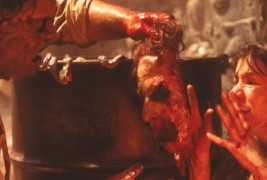
…And the Economics Behind Why We Must Endure Them in the First Place
“Greed, for lack of a better word, is good.” – Gordon Gekko, Wall Street (1987)
I’m sure you clicked on this article expecting to read a fun list of good horror movie sequels. We’ll certainly get to that, but first I have to ask that you indulge me while I’m perched high atop a soapbox of sorts. And if it makes you feel any better, please, by all means envision the soapbox as a decrepit and gothic monolith and me, a gargoyle with a terrifying visage.
Horror in the 1980s gave rise to the movie “franchise”—a business term having nothing at all to do with the arts—but rather a suit-and-tie way of describing the uninhibited sequel-making of successful horror properties in an attempt to rake in the cash. If you were tired of the glut of sequels in the ‘80s, then the current nonstop remaking of those movies is probably killing you. Why must we endure it?
America is a country run by corporations for corporations. The movement that made it so really gained traction in the early 1980s with the disastrous economic myth referred to as Reaganomics—the notion that if we allow corporations free reign, the rest of us will reap the rewards as they trickle down from atop the corporate ivory tower. But when you consider the roots of problems such as declining wages, jobs going overseas, exploding healthcare costs, poisonous food and water, the erosion of consumer and worker rights, and even the potential for an uninhabitable planet in the not-too-distant future, you need not look any further than unrestrained corporate power.
As the decades have slipped by, these policies have been implemented and exacerbated by every administration, Republicans and Democrats, to varying degrees and we’ve been saddled with horrible, widespread consequences. We’ve been tricked, bamboozled—hoodwinked, even—by our corporate politicians telling us through our corporate media that up is down and left is right. In fact, ever since the modern iterations of these policies led to the bottom dropping out of our economy in 2008, a good portion of the American electorate continues to fight tooth and nail to allow corporations to erode everything in sight in the name of profit and all under the false pretense that somehow the electorate will benefit. Pay no mind to the fact that this is antithetical to all available data.
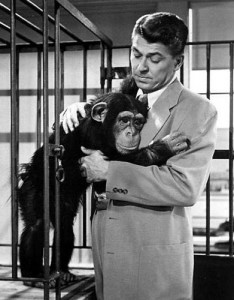
Healthcare and the environment, jobs and the economy—these are big issues. Why is this being discussed on a horror website, you ask? Because this uniquely American problem doesn’t spare the minutiae of our lives from the disastrous effects of corporate greed. And this, Horror Fans, is where the article you were looking for begins.
That’s right. American horror movies have suffered the wrath of the economic philosophy first employed by conservative saint Ronald Reagan—a B-movie star, fittingly enough. Right now this wrath comes in the form of the incessant remaking of every horror movie ever made. This short-sighted, cynical exploitation of our most important genre works is incredibly damaging to the long term health of the genre. That’s in part because it insidiously wears away the soul of the source material while yielding nothing new. For example, it’s difficult to watch A Nightmare on Elm Street without feeling like the putrid 2010 remake has somehow irreparably damaged the film’s legacy to some extent.
As is usually the case though, the corporate greed of the ‘80s was slightly less damaging than its modern counterpart if only because the infrastructure required to trick us into accepting it hadn’t yet been fully realized. What this means, Horror Fans, is that in the ‘80s studios were all about horror movie sequels.
Sequels by their very nature can at least expand a movie’s mythos by contributing something new to it rather than strip mining away its essence. And while the vast majority of sequels are absolutely worthless, American horror movie history is speckled with rare examples of sequels that are truly extraordinary. It follows that over half of the movies included on this list come from the era that shifted the corporate paradigm to Greed is Good. Many of these movies were made for the wrong reasons. Most of these movies have no business being any good at all. But whether or not these films exist because of a “Greed is good” mantra matters not. The important thing is that these films work and they do so against all odds.
So, with that I ask you to please pardon my history lesson on the Art-vs.-Commerce debate and enjoy this list of the best horror movie sequels while I figure out a way to swoop down from this rather uncomfortable soapbox….
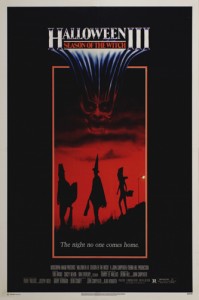 10. Halloween III: Season of the Witch (1982): In the interest of full disclosure, this is a movie that I couldn’t stand as a kid, largely due to the lack of a certain knife-wielding, Kirk’s face-wearing monster that, in the midst of the golden era of slasher flicks, was all too important. A movie named Halloween without such an element just didn’t do it for me. However, 30-plus years of retrospection is plenty of time to clear one’s thoughts and gain new insight and perspective on a film that’s aged surprisingly well over the decades.
10. Halloween III: Season of the Witch (1982): In the interest of full disclosure, this is a movie that I couldn’t stand as a kid, largely due to the lack of a certain knife-wielding, Kirk’s face-wearing monster that, in the midst of the golden era of slasher flicks, was all too important. A movie named Halloween without such an element just didn’t do it for me. However, 30-plus years of retrospection is plenty of time to clear one’s thoughts and gain new insight and perspective on a film that’s aged surprisingly well over the decades.
Halloween III is the first and only attempt at transforming the series into a high-concept multi-year horror anthology unified by its titular holiday. However, as evidenced by its existence as a total anomaly, I was not in the minority in my unenthusiastic reaction back then. The movie stars Tom Atkins as Dr. Challis who teams up with a deceased patient’s daughter to find the patient’s killer. Their quest to solve the mystery leads them to the Silver Shamrock Novelty factory where they uncover killer Halloween masks, killer robots, and a sinister plan to kill all the children on Halloween night. Quite frankly, Halloween III is a weird movie that didn’t work all that well 30 years ago, doesn’t always work well now, but it strives to be something different…it strives to be weird. And in that respect it’s a complete success.
There have been other outside-the-box and daring entries into the major slasher franchises, such as Friday the 13th Part 5: A New Beginning and Wes Craven’s A New Nightmare, but none of them jump as gleefully down the rabbit hole as Halloween III does.
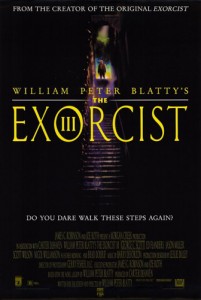 9. The Exorcist III (1990): You want pure movie studio cynicism? The Exorcist II. The tonally incomprehensible fool’s errand of a movie is entirely made to capitalize on its brilliant predecessor. Fortunately though, The Exorcist III leapfrogs that embarrassing middle child of the Exorcist series and comes back with something that’s dark, sophisticated and not altogether predictable. Written and directed by William Peter Blatty and based on his book Legion, The Exorcist III depicts a series of Georgetown murders and the subsequent investigation by Lieutenant William Kinderman (George C. Scott). The killings appear to be both linked and Satanic. In fact they bear a strong resemblance to the work of a serial killer—Gemini (Brad Dourif)—who’s been dead for a decade-and-a-half. As the murders continue, the answer to the mystery of who’s responsible may lie with a familiar face found within the walls of a mental hospital.
9. The Exorcist III (1990): You want pure movie studio cynicism? The Exorcist II. The tonally incomprehensible fool’s errand of a movie is entirely made to capitalize on its brilliant predecessor. Fortunately though, The Exorcist III leapfrogs that embarrassing middle child of the Exorcist series and comes back with something that’s dark, sophisticated and not altogether predictable. Written and directed by William Peter Blatty and based on his book Legion, The Exorcist III depicts a series of Georgetown murders and the subsequent investigation by Lieutenant William Kinderman (George C. Scott). The killings appear to be both linked and Satanic. In fact they bear a strong resemblance to the work of a serial killer—Gemini (Brad Dourif)—who’s been dead for a decade-and-a-half. As the murders continue, the answer to the mystery of who’s responsible may lie with a familiar face found within the walls of a mental hospital.
The Exorcist III is a slow-burning crime drama with the addition of supernatural elements. It’s bleak and beautifully shot as well. But its real strength is its cast which is comprised of some of the greatest character actors in history, all of whom had prior genre experience coming into the production. They include the aforementioned George C. Scott (The Changeling, Firestarter) and Brad Dourif (One Flew Over the Cuckoo’s Nest, Child’s Play, Deadwood, Lord of the Rings…actually Dourif’s career is so amazing that unless I stop now this parenthetical will be several pages long), as well as Jason Miller (The Exorcist), and Scott Wilson (The Walking Dead). Even after infamous and significant meddling by studio Morgan Creek, The Exorcist III remains a sequel of substance. For more on The Exorcist III you should check out Dr. Abner Mality’s retrospective published here on Ravenous Monster.
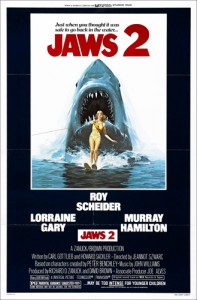 8. Jaws 2 (1978): To put it simply, Jaws (1975) is a masterpiece. It’s also considered the first summer blockbuster which meant that Universal Studios started floating the idea of a sequel almost immediately after its release. Director Steven Spielberg refused to jump aboard and star Roy Scheider wanted nothing to do with it. But in Hollywood, money talks and, in fact, sometimes it yells. So production inevitably commenced on Jaws 2 and despite the first director being relieved of his duties, several script rewrites and Scheider’s complete disinterest in the film, Chief Brody (Scheider), his wife Ellen (Lorraine Gary), Mayor Vaughn (Murray Hamilton) and even John Williams’s brilliant orchestra all returned for another try…as did “Bruce” the mechanical shark that once again rarely worked.
8. Jaws 2 (1978): To put it simply, Jaws (1975) is a masterpiece. It’s also considered the first summer blockbuster which meant that Universal Studios started floating the idea of a sequel almost immediately after its release. Director Steven Spielberg refused to jump aboard and star Roy Scheider wanted nothing to do with it. But in Hollywood, money talks and, in fact, sometimes it yells. So production inevitably commenced on Jaws 2 and despite the first director being relieved of his duties, several script rewrites and Scheider’s complete disinterest in the film, Chief Brody (Scheider), his wife Ellen (Lorraine Gary), Mayor Vaughn (Murray Hamilton) and even John Williams’s brilliant orchestra all returned for another try…as did “Bruce” the mechanical shark that once again rarely worked.
Much like the first film, Chief Brody discovers evidence that Amity Island has a shark problem and again Mayor Vaughn decides to ignore the evidence, deferring instead to the short-sighted financial interests of the tiny resort town…similar to the way movie studios push forward with ill-conceived sequels and remakes, as a matter of fact. Chief Brody, understandably jumpy from the events depicted in Jaws, mistakes a school of fish for the silhouette of a monster shark, freaks out and fires his gun into air, clearing the beach and causing mass hysteria. As a result, he’s fired. But when his now-teenaged children go sailing into the treacherous waters, Brody commandeers a police boat and sets out to save them from Bruce.
Director Jeannot Szwarc’s sequel is a fairly competent follow up that eschews character development and suspense for taut action and fast pacing. By the time Jaws 2 came about, horror culture was shifting to full-on explicit slasher mode, yet this film managed to do quite well. As opposed to the first film, here we see the shark. We see it a lot. All the time, really. And by pitting a group of teenagers against the rogue Great White, one only needs to imagine the shark wearing a hockey mask and replace the woods with the ocean and you get the idea. This approach combined with one of the best marketing campaigns ever, one that included toys and games that this writer still owns and proudly displays, as well as the greatest tagline in movie history—“Just when you thought it was safe to go back in the water…,” Jaws 2 can’t be considered anything other than an objective success.
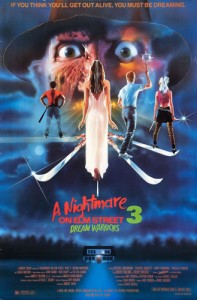 7. A Nightmare on Elm Street 3: Dream Warriors (1987): In an attempt to capitalize on the success of A Nightmare on Elm Street, its sequel was hastily rolled off the assembly line and into theaters. To the surprise of few, it was a lemon. Wes Craven wasn’t involved and the results are telling. With a third film looking like an inevitability, Craven jumped back onboard despite his reluctance to turn Elm Street into another franchise. He co-wrote a script that was cleaned up by Frank Darabont (The Walking Dead, The Green Mile, The Shawshank Redemption) and in 1987 Freddy was back on the big screen with A Nightmare on Elm Street 3: Dream Warriors.
7. A Nightmare on Elm Street 3: Dream Warriors (1987): In an attempt to capitalize on the success of A Nightmare on Elm Street, its sequel was hastily rolled off the assembly line and into theaters. To the surprise of few, it was a lemon. Wes Craven wasn’t involved and the results are telling. With a third film looking like an inevitability, Craven jumped back onboard despite his reluctance to turn Elm Street into another franchise. He co-wrote a script that was cleaned up by Frank Darabont (The Walking Dead, The Green Mile, The Shawshank Redemption) and in 1987 Freddy was back on the big screen with A Nightmare on Elm Street 3: Dream Warriors.
This film is successful for several reasons not the least of which is because it expands the Elm Street mythos and scope in creative ways giving it substance that helps it work on its own merits. The premise brings back Nancy Thompson (Heather Langenkamp), all grown up and using her dream and psychology expertise as a Doctor to help a group of institutionalized teenagers. Naturally, these troubled teens are all being stalked in their dreams by the infamous Freddy Krueger (Robert Englund). Under the guidance of Dr. Nancy, the teens discover they are endowed with special powers when they dream, setting up some outstanding action sequences. We’re also given Freddy’s despicably mythic origin story—an important ingredient of horror iconography.
The film’s demanding FX and high-concept set pieces as well as its abundantly talented cast and crew including director Chuck Russell (The Blob remake, The Mask), a debuting Patricia Arquette as the teenaged lead Kristen, veteran Laurence Fishburne and the aforementioned Langenkamp, Englund, and John Saxon reprising their roles as Nancy, Freddy, and Nancy’s father Donald Thompson, respectively, all set Dream Warriors apart from any of the other sequels in the franchise. While the unfortunate seeds of Freddy Krueger’s annoying stand-up comedy career are indeed sown here, Dream Warriors is as unique and entertaining a horror movie as anything in the genre.
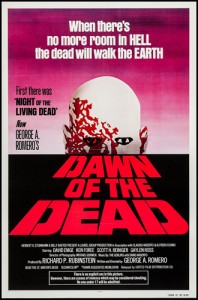 6. Dawn of the Dead (1978): It’s difficult to explore any part of our pop cultural landscape these days without finding representations of the walking dead. Zombies are everywhere and there’s no sign of the trend dying (ahem…) anytime soon. Our conception of the zombie was born in 1968 upon the release of George A. Romero’s Night of the Living Dead. Not only was NOTLD the genesis of the modern zombie, but it was also in many ways the genesis of the modern horror film as it was an early example of modern realism in genre filmmaking. It is decidedly non-Victorian-Gothic, nor is it Cold War-induced Science Fiction. No, NOTLD was one of the first horror films shaped by the war in Vietnam and the American Civil Rights Movement, events that made the ideas of society devouring itself and having to stare death in the face realities in many places.
6. Dawn of the Dead (1978): It’s difficult to explore any part of our pop cultural landscape these days without finding representations of the walking dead. Zombies are everywhere and there’s no sign of the trend dying (ahem…) anytime soon. Our conception of the zombie was born in 1968 upon the release of George A. Romero’s Night of the Living Dead. Not only was NOTLD the genesis of the modern zombie, but it was also in many ways the genesis of the modern horror film as it was an early example of modern realism in genre filmmaking. It is decidedly non-Victorian-Gothic, nor is it Cold War-induced Science Fiction. No, NOTLD was one of the first horror films shaped by the war in Vietnam and the American Civil Rights Movement, events that made the ideas of society devouring itself and having to stare death in the face realities in many places.
Fast forward ten years and Romero’s Dawn of the Dead is another outstanding reflection of the society in which it was conceived, purposely or not. DOTD represents the evolution of the original film’s premise. Rather than taking place within the confines of a claustrophobic and isolated farmhouse, Dawn shows us what happens when suburbia is overrun by the ravenous horde. Our new group of survivors holes up inside a shopping mall this time and until a looting biker gang destroys their little utopia, they have it pretty good given the fact that the world is ending. While NOTLD is very well regarded, Dawn shares very little with its predecessor, aesthetically, narratively, or technically and that seems to have actually contributed to its own success.
In exchange for international distribution rights, Dawn of the Dead was financially backed by Italian horror genius Dario Argento who had been significantly inspired by Romero’s first zombie opus the previous decade. Aesthetically, DOTD shares much with the films of the Italian splatter icon Lucio Fulci and the aforementioned Argento. And while it’s widely considered a brilliant metaphor for American consumerism it’s also the most notable American example of the great global exploitation/horror films of the late-‘70s and early-‘80s. Everything from its cinematography to its score is endemic of this outstanding era which also bestowed us with movies such as Susperia, Zombi, Escape from New York and many others of a similar mold.
Dawn of the Dead features music from the now-iconic band Goblin, make-up and FX by Tom Savini that raised the bar for gonzo gore to heights never before seen and thrust Savini into horror super-stardom, and it gave us star Ken Foree, a great character actor who’s now considered one of the top horror icons from that era. Dawn of the Dead was well regarded upon its release and in the time since then it has cemented its legacy as one of the best genre films of all time.
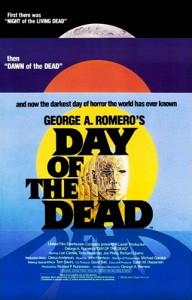 5. Day of the Dead (1985): The third film of Romero’s zombie canon further evolves the concept of the first two chapters and depicts life in one tiny corner of a world that’s been entirely overrun by the walking dead. This time our heroes are military personnel and scientists who are residing together inside a claustrophobic underground bunker. The scientists believe that zombies can be “domesticated” eventually allowing us to cohabitate with them safely. The military folks think this idea is ridiculous and the result is internal strife within the group. Dr. Logan’s proof of concept is a zombie named Bub who seems tame and also appears to remember fragments of his life. As is always the case, we inevitably find out that the real danger posed to our protagonists is not the living dead, but the living as tensions within the group boil over. Day presents this idea explicitly.
5. Day of the Dead (1985): The third film of Romero’s zombie canon further evolves the concept of the first two chapters and depicts life in one tiny corner of a world that’s been entirely overrun by the walking dead. This time our heroes are military personnel and scientists who are residing together inside a claustrophobic underground bunker. The scientists believe that zombies can be “domesticated” eventually allowing us to cohabitate with them safely. The military folks think this idea is ridiculous and the result is internal strife within the group. Dr. Logan’s proof of concept is a zombie named Bub who seems tame and also appears to remember fragments of his life. As is always the case, we inevitably find out that the real danger posed to our protagonists is not the living dead, but the living as tensions within the group boil over. Day presents this idea explicitly.
Romero intended Day to be a large-scale finale to his zombie apocalypse, but a lack of resources necessitated he recalibrate to the much smaller-scale intimate film we ended up getting. Day didn’t do particularly well in theaters and it wasn’t very enthusiastically received by critics, but over time it’s garnered a loyal group of fans, myself included. It’s my favorite of the original Dead trilogy, largely because it’s aged the most gracefully. Day is the most conventional of the three films and it features more Savini FX, this time depicted realistically, as opposed to the cartoonish colors and motifs featured in Dawn. The results are incredible and many of the gags have attained icon-status such as “Dr. Tongue” and of course Bub.
Day represents the end of an era as it’s one of the last exploitation/horror flicks of its kind. Much of what came in its wake was glossy slasher sequels and then the abysmal horror vacuum of the 1990s.
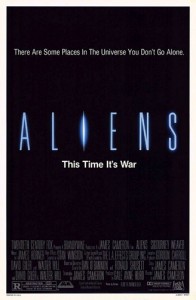 4. Aliens (1986): Ridley Scott’s Alien (1979) is an intimate and claustrophobic horror film, through and through. Its sequel, Aliens is the brainchild of visionary James Cameron and as such it’s much more of a huge sci-fi spectacle than it is a horror movie, but a horror movie sequel it is. Coming on the heels of The Terminator, Cameron’s combat-heavy Aliens depicts what are essentially futuristic marines who are sent by the skeptical Weyland-Yutani Corporation to the planet where Ripley and company first encountered the alien eggs almost fifty years earlier, this time to figure out why communication from a “terraforming” colony has gone silent. Ripley (who had been in stasis for most of those 47 years, natch) is sent along as a consultant. What follows is an over-the-top extravaganza of crazy futuristic weaponry and vehicles, explosions, and jaw-dropping set pieces not to mention the multiple astounding aliens courtesy of the late, great animatronics wizard Stan Winston. Aliens also features genre stalwarts Lance Henrickson (Pumpkinhead), Michael Biehn (Terminator), and Bill Paxton (Near Dark) and of course the great Sigourney Weaver as Ripley. With a budget this large and a cast and crew this talented, it should come as no surprise that Aliens is in the top-five.
4. Aliens (1986): Ridley Scott’s Alien (1979) is an intimate and claustrophobic horror film, through and through. Its sequel, Aliens is the brainchild of visionary James Cameron and as such it’s much more of a huge sci-fi spectacle than it is a horror movie, but a horror movie sequel it is. Coming on the heels of The Terminator, Cameron’s combat-heavy Aliens depicts what are essentially futuristic marines who are sent by the skeptical Weyland-Yutani Corporation to the planet where Ripley and company first encountered the alien eggs almost fifty years earlier, this time to figure out why communication from a “terraforming” colony has gone silent. Ripley (who had been in stasis for most of those 47 years, natch) is sent along as a consultant. What follows is an over-the-top extravaganza of crazy futuristic weaponry and vehicles, explosions, and jaw-dropping set pieces not to mention the multiple astounding aliens courtesy of the late, great animatronics wizard Stan Winston. Aliens also features genre stalwarts Lance Henrickson (Pumpkinhead), Michael Biehn (Terminator), and Bill Paxton (Near Dark) and of course the great Sigourney Weaver as Ripley. With a budget this large and a cast and crew this talented, it should come as no surprise that Aliens is in the top-five.
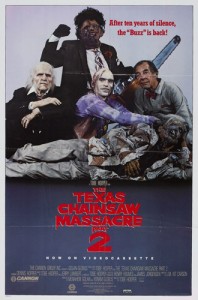 3. The Texas Chainsaw Massacre 2 (1986): After more than a decade Tobe Hooper was back in the director’s chair to helm this sequel to what is arguably one of the greatest horror films ever made. What makes TCM2 unique is its (eventual) success despite being drastically different from its predecessor in almost every way. Gone is the grainy vérité aesthetic and blood pressure-exploding intensity. In its place Hooper weaves an absurdist follow up that’s heavy on pitch-black comedy and where the original featured scant gore, Tom Savini delivers buckets—heck, end-loaders full of it—in this carnivorous carnival from hell set beneath an abandoned amusement park. The film also launched the career of one of the genre’s best and most beloved character actors, Bill Moseley, in the role of Chop Top.
3. The Texas Chainsaw Massacre 2 (1986): After more than a decade Tobe Hooper was back in the director’s chair to helm this sequel to what is arguably one of the greatest horror films ever made. What makes TCM2 unique is its (eventual) success despite being drastically different from its predecessor in almost every way. Gone is the grainy vérité aesthetic and blood pressure-exploding intensity. In its place Hooper weaves an absurdist follow up that’s heavy on pitch-black comedy and where the original featured scant gore, Tom Savini delivers buckets—heck, end-loaders full of it—in this carnivorous carnival from hell set beneath an abandoned amusement park. The film also launched the career of one of the genre’s best and most beloved character actors, Bill Moseley, in the role of Chop Top.
Essentially occupying the space of the original film’s Hitchhiker role (only way more bizarre, believe it or not), Chop Top is The Hitchhiker’s twin and the loony cannibal brother of Leatherface and The Cook. He was wounded in Vietnam and he habitually uses a coat hanger to scrape the skin from the steel plate in his head and snack on it. Yup…. And in another stroke of casting genius, Dennis Hopper plays our knowing police lieutenant hero. Much like the top movie on this list, Hooper’s shift in tone and approach is the type of thing that happens when the same director revisits a world and its inhabitants that he or she created. Often times, these changes yield challenging and exciting results that aren’t necessarily appreciated right away. The Texas Chainsaw Massacre 2 does that and more.
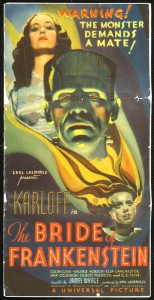 2. Bride of Frankenstein (1935): To the film geeks and true horror aficionados among you, Bride’s inclusion on this list is a no-brainer, but to some of the more casual horror buffs and movie fans out there, well, you may be a little confused. Admittedly, the movie’s title—which has been imitated by countless low-rent exploitation and horror flicks over the decades—as well as the iconic imagery of Elsa Lanchester’s Bride maniacally staring off screen, her face frozen in shock and framed by her hovering Nefertiti hair is enough to give one pause. Not to mention the movie’s broad, ostensibly silly concept. However, the consensus on Bride is that it’s director James Whale’s “masterpiece” and it’s representative of top-flight filmmaking in all facets, from acting and directing to make-up and musical score. In fact, Bride is on the short list of films that have been added to the United States National Film Registry for being culturally, historically, or aesthetically significant.
2. Bride of Frankenstein (1935): To the film geeks and true horror aficionados among you, Bride’s inclusion on this list is a no-brainer, but to some of the more casual horror buffs and movie fans out there, well, you may be a little confused. Admittedly, the movie’s title—which has been imitated by countless low-rent exploitation and horror flicks over the decades—as well as the iconic imagery of Elsa Lanchester’s Bride maniacally staring off screen, her face frozen in shock and framed by her hovering Nefertiti hair is enough to give one pause. Not to mention the movie’s broad, ostensibly silly concept. However, the consensus on Bride is that it’s director James Whale’s “masterpiece” and it’s representative of top-flight filmmaking in all facets, from acting and directing to make-up and musical score. In fact, Bride is on the short list of films that have been added to the United States National Film Registry for being culturally, historically, or aesthetically significant.
As is the case with some other entries on our list, Whale was reluctant to revisit the Frankenstein material at first and even after he’d finally agreed to do so, the movie languished in production hell for years. Several scripts were rejected outright before one was developed based on the minor subplot from Mary Shelley’s novel in which the monster demands that Henry create him a companion. Boris Karloff (Frankenstein’s monster) and Elsa Lanchester (the Bride, Mary Shelley) are nearly as iconic as their characters are and of all the great Universal Monster movies including Frankenstein (1931), Bride of Frankenstein is the pinnacle.
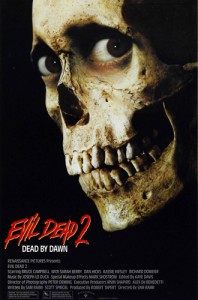 1. Evil Dead 2 (1987): This movie is as outstanding as it is bananas. But it came about more out of necessity than anything else. The crew behind the original accidental hit—Sam Raimi, Rob Tapert, and Bruce Campbell, had moved on from horror after The Evil Dead (1981) and were bound and determined to make it big by way of their next movie—Crimewave (1985), a comedy that if you’ve heard of it at all, it’s because you’re a horror fan who loves the Evil Dead movies. And THAT speaks volumes about the motivation to make an Evil Dead sequel. All of us, including these brilliant filmmakers, should be thankful that Crimewave bombed.
1. Evil Dead 2 (1987): This movie is as outstanding as it is bananas. But it came about more out of necessity than anything else. The crew behind the original accidental hit—Sam Raimi, Rob Tapert, and Bruce Campbell, had moved on from horror after The Evil Dead (1981) and were bound and determined to make it big by way of their next movie—Crimewave (1985), a comedy that if you’ve heard of it at all, it’s because you’re a horror fan who loves the Evil Dead movies. And THAT speaks volumes about the motivation to make an Evil Dead sequel. All of us, including these brilliant filmmakers, should be thankful that Crimewave bombed.
Director Sam Raimi effectively uses the first 20 minutes of Evil Dead 2 to retell the plot of The Evil Dead and then proceeds to go crazy with a hilarious, gross, and surreal trip into horror infamy. Bruce Campbell’s second turn as Ash—a snarky everyman antihero who fights his friends-turned-deadites in and around a rural cabin in the middle of nowhere—is absurdly funny and painfully masochistic. The better part of the movie’s second act consists of Bruce Campbell talking to himself as he fights his own hand in a grotesque one-man Three Stooges routine that’s as original and iconic as anything ever filmed in this genre. The scene that seals the deal is the movie’s finale. After nearly an hour-and-a-half of bizarre, entertaining craziness, the film ends by audaciously vaulting itself over the top so high and far that exactly zero people guessed the ending of Evil Dead 2. I write this with complete confidence. The score, the FX, the cinematography, the mythos – Evil Dead 2 is the total package for people who love weird cinema.
The Best of the Rest:
28 Weeks Later (2007): This is a well-made, well-acted follow up that is, for all intents and purposes, a more concise, faster-paced, and frankly more entertaining do-over of the highly regarded 28 Days Later. There’s a lot less depth and a lot more action. “The infected” still sprint with Olympic speed through set pieces to rip our heroes and their friends into pulpy bits only now there are fewer lulls in between such episodes.
The Devil’s Rejects (2005): This follow up to Rob Zombie’s debut bonanza, House of 1000 Corpses, showcases everything the neophyte filmmaker does well as well as everything he does poorly. Eschewing the cartoonish aesthetic of the original, Rejects takes a much grittier, realistic tack and it also forces us to empathize with the Firefly Clan, the notorious homicidal villains from the original movie. If nothing else, Rejects flashes glimpses of Zombie’s enormous filmmaking potential.
Halloween II (1981): Halloween II takes place immediately after the original film ends. This isn’t a fantastic movie by any means but it’s a strong representation of the slasher genre and probably the last time we get to enjoy The Shape before the Myers mythos gets silly. Michael Myers stalks Laurie Strode all night long throughout an enormous, dark hospital. Nothing more. Nothing less. It’s intense, no nonsense slasher goodness.
Maniac Cop 2 (1990): William Lustig brings back from the dead his antagonist, Officer Matthew Cordell, who’s now basically a really mean zombie. He’s scarier than ever, redefining the idea of police brutality as he dispatches his foes through one crazy action sequence after another. In fact, this follow up features some of the best action set pieces this side of the ‘80s. Maniac Cop 2 is a top notch B-Movie and if you haven’t seen it, “you have the right to remain silent…Forever!”
4 thoughts on “The 10 Best Horror Movie Sequels…”
Comments are closed.


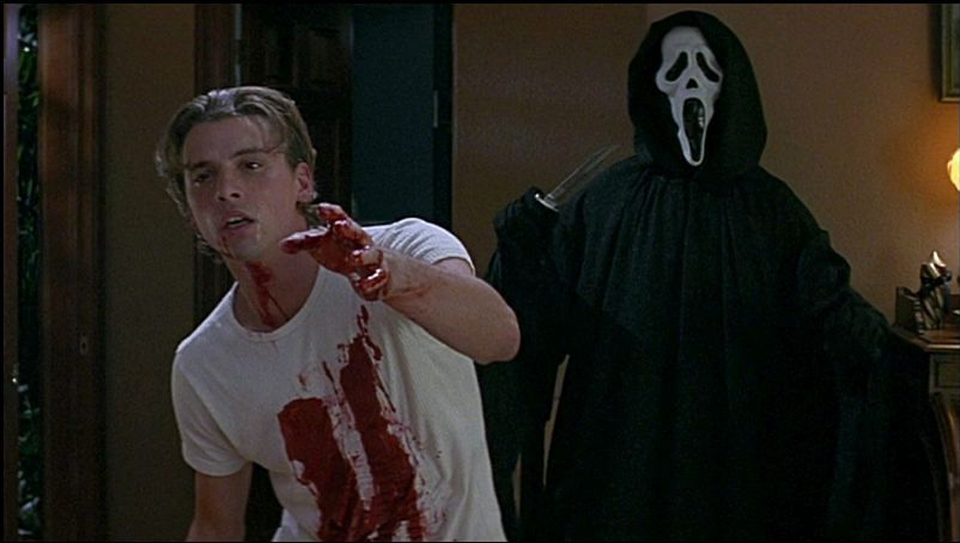

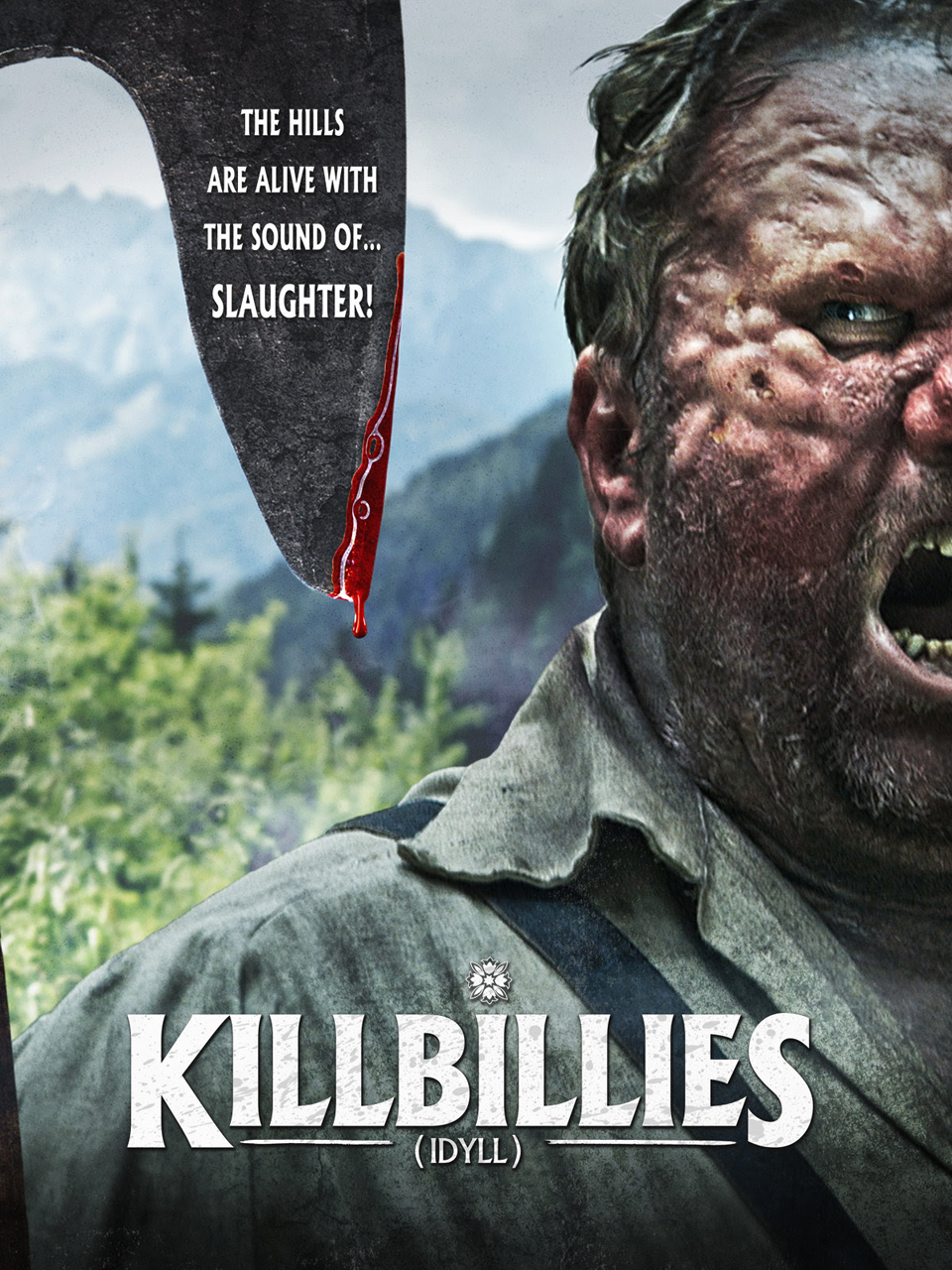










Outstanding piece! Well done!
Thanks very much, Bowie!
Great list, every choice made sense.
Thanks Jake!